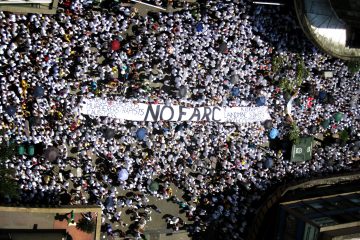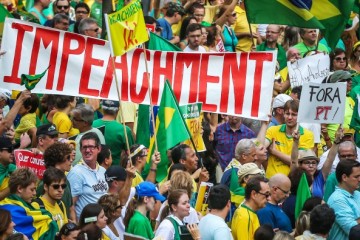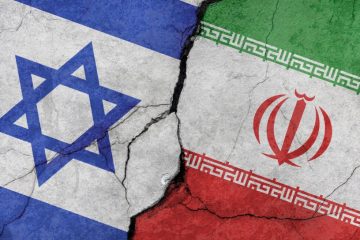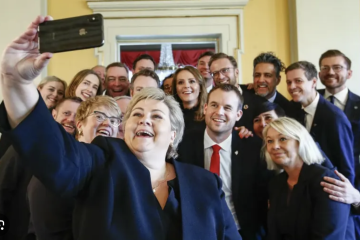
What will the peace process mean for Colombia’s border regions? The government will have to start governing.
The “how” and the “when” of Colombia’s latest peace breakthrough are of course important — but so is the “where” and “with whom.” On June 23, the Colombian government and the Revolutionary Armed Forces of Colombia-People’s Army (FARC) signed a bilateral ceasefire agreement, after more than five decades of armed conflict. For Colombia’s peace process to succeed, it will need to break the cycle of conflict, organized crime and state neglect in Colombia’s border regions. The agreement stipulates that the FARC lay down its weapons within 180 days of a final peace deal, which has a July target date. The disarmament will take place in 23 specific “normalization zones” and eight camps, all of which cease to exist after these 180 days. The …

Brazil’s delicate foundations are falling apart like a house of cards
A cornered government, a legislative short of legitimacy, a contaminated judiciary and polarised protesters put Brazilian institutional balance to the test. Immoral deals, Machiavellian manoeuvres and outright dishonesty. No wonder comparisons between Brazilian politics and the American TV show House of Cards are tempting and widespread. Even Netflix made the connection to promote the release of its fourth series in Brazil. This clever marketing initiative prompted Maurício Santoro, a political scientist, to joke on Twitter that “Netflix is the only institution enjoying the trust and esteem of Brazilians these days.” But Brazil’s plight is not fiction, and the quip accompanies a concerning realisation. For some time, even in the face of turmoil and economic meltdown, it was possible to believe …

Have the mass media fuelled Brazil’s turmoil?
As any country with a minimally functioning democracy, Brazil has an ambivalent relationship with its mass media. And as in all countries with a minimally functioning market economy, Brazilian mass media have been disrupted by personalised digital platforms. Understanding To two elements, and how they became entangled, is essential if we are to grasp the role of the media in the social turmoil that has engulfed Brazil in the past year or so.
But in spite of their deep flaws, newspapers and broadcasters cannot be blamed for the toxic political environment that has taken over the country.

Clinton v. Trump: How Hillary Wins the Narrative Game
In the likely event that Hillary Clinton secures the Democratic nomination by the end of May or early June, the task of uniting the party behind her will be much less onerous than that of whoever emerges from the GOP field. For Republicans, a ‘brokered’ convention looms on the horizon. And, given the severely fractured status of the conservative movement in America, it will be hard for any candidate—Trump or otherwise—to appeal to a national constituency that seems to lack any consensus on what it means to even be “conservative.” Secretary Clinton, on the other hand, would have the time and resources to bring unity to her platform and to her party following what has been an impressive challenge by Vermont Senator Bernie Sanders.

Trading Water: Could Markets Be One Solution to California’s Water Woes?
Drought-stricken California is taking unprecedented measures to address its water challenges.
In April, the governor issued the first mandatory statewide water use restrictions in California history, after snowpack in the Sierra Nevada Mountains—which provide 60 percent of the state’s water—fell to the lowest levels ever recorded. San Diego County is building the largest seawater desalination plant in the Western hemisphere, while Orange County plans to turn more wastewater into drinking water.
The solutions are significant because the drought has been exceptionally severe. It currently affects over 99 percent of the state and approximately 37 million people. In 2014, the state agriculture industry lost roughly $2.2 billion to drought, and some California communities even ran out of water.
One solution California may consider is whether more efficient, user-friendly water markets would help water users adapt more quickly to drought conditions, and better cope with long-term water scarcity stemming from climate change and increased water demand.
California has active water markets, but buying and selling water (and water rights) there is not as simple as in Australia, where it is said to be “almost as easy to sell water from your water bank account as it is to transfer money from a normal bank account.” The Australian model could be useful for California because Australia recently emerged from a decade-long drought, during which it pioneered water policies that attracted interest from water-scarce countries around the world.
Why is water trading easier in Australia? One reason is that Australia’s water rights system has been made relatively simple and predictable. It is designed so that rights holders can generally expect to receive a certain percentage of their water every year, based on the type of water right they hold. This makes water rights’ value easier to determine; the water rights transfer process is also less onerous.

Questioning traditional citizenship: memory, identity and collective action in Chile
In this post I contest traditional liberal conceptions of citizenship rooted in the nation-state and consider the role played by memory in the ways in which Santiago de Chile’s disenfranchised produce contentious politics.
I suggest that, by referring to the past in their meetings and conversations, local neighbourhood organisations in Santiago de Chile’s poor settlements (poblaciones) assert a particular, anti-hegemonic interpretation of history. Through stories, historical anecdotes, and different types of memorials, poor residents produce a neighbourhood identity, giving rise to innovative forms of community membership.
Referring to the influence of the past in contentious politics in the favelas, James Holston has also proposed novel approaches that allow a rescaling of citizenship. In his book Insurgent Citizenship, Holston (2008) argues that history lurks below the surface of our porous present, sometimes leading to the eruption of movements that question historically entrenched regimes of urban citizenship. However, Holston does not explain precisely how this determining relationship between history and contentious mobilisation occurs. My ethnographic research in Santiago’s poblaciones explores this issue directly, examining the role of memory in the production and re-production of an identity of struggle.

Plurinational citizenship in the making
In 2009, after a long and contentious process of national dialogue that led to the approval of a new Constitution, the Republic of Bolivia officially changed its name to Plurinational State of Bolivia.
Over the last decade, the idea of plurinationalism has influenced public debates across the Andean region. In 2008, the Ecuadorian president Rafael Correa defined plurinationalism as the coexistence of several different nationalities within a larger state where different peoples, cultures and worldviews exist and are recognized. Yet, Bolivia was the first country to go all the way, not only including this idea in the Constitution (as Ecuador did) but actually changing its official name. This is not just a formality. The new Bolivia is engaging in a process of in-depth institutional reforms, challenging mainstream narratives and political structures and reinventing a model of the state and creating notions of citizenship better suited to highly diverse ethnic and cultural landscapes.
In Latin America, the effort to challenge assimilationist and universalist models of citizenship (both republican and corporatist) took shape during the 1990s, when multicultural politics emerged and culture and identity became legitimate political claims. However, multiculturalism was not an easy partner for the neoliberal consensus, and claims for collective (rather than individual) rights and for territorial autonomy raise what Deborah Yashar (1999) calls a “postliberal challenge”. While concepts such as multiculturalism and pluricultural citizenship were a key part of the neoliberal agenda, it was with the Leftist turn in the following decade that the more radical idea of a plurinational state took shape. In Bolivia, the election of Evo Morales as President in 2005 and the rise of the Movement Towards Socialism (MAS) gave political meaning to plurinationalism as an alternative model of state and citizenship, which was meant to overcome the neoliberal multicultural framework for diversity management.

How do editors choose which human rights news to cover? A case study of Mexican newspapers
The mass media forms a key channel through which instances of human rights violations are made public. However, the media can only publish a small proportion of stories, as media practitioners are required to sift through wider information, deciding what to cover. A media ethnography conducted in Mexico in 2006, before and after the presidential elections, can illuminate what journalists are trying to do in their human rights coverage and how their outlooks and contexts condition the incidents that are covered.
Parts of the Mexican media played a significant role in the country’s democratic transition since the 1976 Tlateloco Massacre, resulting in a general shift among journalists away from a cozy and financially lucrative relationship with the government. This led to the growth of new ‘market-oriented’, as opposed to ‘state-oriented’, newspapers. Both usually have a human rights beat investigating citizens’ complaints about infractions committed by state institutions. This often involves collaboration with the independent human rights commissions established in the 1990s.
Within this context, this case of Mexico suggests the mixture of outlooks and contexts affecting processes of extracting human rights news from wider information can be put into four categories: newsworthiness, journalistic aims, economic aims and political aims. A human rights story is more likely to be published by a newspaper the more it corresponds to these criteria.
The first factor, newsworthiness of a story, appears to be tricky to define; many of the editors interviewed claim it was a ‘sentiment’ that was ‘uncertain’, ‘improvised’ or ‘arbitrary’. Still, their explanations suggest some common criteria for newsworthiness. Firstly, published stories generally concerned incidents where human rights were transgressed rather than respected. One editor of El Universal explained ‘human rights are there to be taken care of … Therefore it is news when they are violated.’ Other aspects of newsworthiness included novelty, exclusivity, impact, representativeness, and timeliness. In particular, the potential political impact of a violation was considered greater, and therefore more ‘newsworthy’, if it involved multiple victims or was particularly severe, as in the case of a 13-year-old girl who was denied a legal abortion after she was raped. Editors also sought to publish stories that were representative of wider problems, such as inequality. The idea, as an editor of El Universal put forward, was ‘that when we talk of inequality or poverty, people have a point of reference’.









